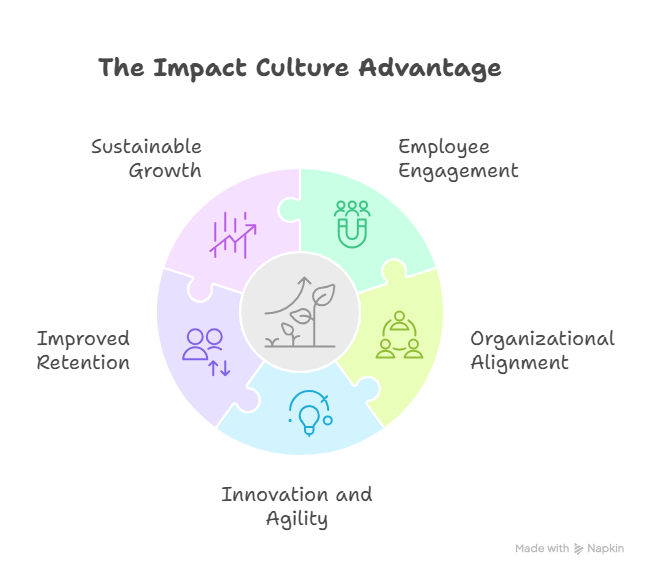In today’s competitive business landscape, organizations need more than just efficient processes and innovative products—they need a culture that drives meaningful impact. A culture of impact ensures employees are engaged, motivated, and aligned with the organization’s purpose, leading to sustainable growth and measurable results.
This article explores strategies for building such a culture, highlighting benefits, actionable approaches, challenges, and success stories that inspire organizational transformation.
Why a Culture of Impact Matters
Organizations that cultivate a culture of impact see:
- Higher employee engagement and satisfaction
- Stronger performance and productivity
- Greater innovation and adaptability
- Enhanced reputation and brand loyalty
- Long-term organizational resilience
Employees who feel their work matters are more committed, proactive, and willing to go the extra mile, creating a positive cycle of achievement and organizational success.
Key Strategies to Build a Culture of Impact
- Define and Communicate a Clear Purpose
A clearly articulated organizational purpose guides decision-making and motivates employees.
- Actionable Tip: Develop a mission statement that reflects the company’s core values and societal impact.
- Impact: Employees understand the “why” behind their work, creating intrinsic motivation.
- Lead by Example
Leaders play a pivotal role in shaping culture. Executives and managers should demonstrate behaviors, attitudes, and values that reflect the organization’s impact-driven goals.
- Actionable Tip: Encourage leaders to participate in initiatives, recognize achievements, and practice transparency.
- Impact: Builds trust and sets a behavioral standard for all employees.
- Empower Employees
Give teams the autonomy to make decisions, experiment, and take ownership of projects. Empowered employees are more engaged and proactive.
- Impact: Fosters innovation, accountability, and a sense of contribution to meaningful outcomes.
- Integrate Recognition and Reward Systems
Acknowledging employees for impactful contributions reinforces desired behaviors and motivates others.
- Actionable Tip: Implement recognition programs tied to measurable outcomes and cultural values.
- Impact: Drives engagement, retention, and a culture of excellence.
- Foster Continuous Learning and Development
A learning culture ensures employees acquire new skills, adapt to change, and remain innovative.
- Actionable Tip: Offer workshops, mentorship programs, and training opportunities.
- Impact: Enhances capabilities, boosts confidence, and strengthens the organization’s competitive edge.
- Encourage Collaboration and Knowledge Sharing
Collaborative environments enable idea exchange, cross-functional teamwork, and shared problem-solving, driving collective impact.
- Impact: Builds stronger relationships, accelerates innovation, and creates alignment across departments.
- Measure and Communicate Impact
Tracking performance against meaningful metrics ensures the organization understands its contribution to stakeholders, society, and business objectives.
- Actionable Tip: Use KPIs, dashboards, and regular updates to communicate progress.
- Impact: Reinforces purpose, drives accountability, and motivates employees to deliver results.
Benefits of Building a Culture of Impact
- Employee Engagement: Motivated employees are more productive and innovative.
- Organizational Alignment: Teams work cohesively toward shared goals.
- Innovation and Agility: Empowered and collaborative teams adapt quickly to market changes.
- Improved Retention: Employees stay with organizations that value impact and growth.
- Sustainable Growth: A purpose-driven culture supports long-term performance and reputation.

Challenges in Cultivating a Culture of Impact
- Resistance to Change: Employees may cling to old habits and processes.
- Lack of Leadership Buy-In: Without commitment from top management, cultural initiatives may fail.
- Poor Communication: Unclear messaging can lead to confusion and disengagement.
- Resource Constraints: Implementing training, recognition, and measurement systems requires investment.
- Measuring Intangible Outcomes: Cultural shifts are often difficult to quantify.
Strategies to Overcome Challenges
Start from the Top: Secure leadership commitment and model desired behaviors.
Communicate Consistently: Use multiple channels to reinforce purpose, goals, and values.
Involve Employees: Encourage feedback, co-create initiatives, and promote ownership.
Invest in Development: Allocate resources for learning, tools, and recognition programs.
Track and Celebrate Wins: Highlight progress to reinforce motivation and adoption.
Final Words
A culture of impact is not just an organizational ideal—it’s a strategic imperative. Companies that actively cultivate purpose-driven, engaged, and empowered teams achieve higher productivity, stronger innovation, and sustainable growth.
At Ebullient, we specialize in transformational organizational training programs that help companies build cultures of impact, enhance leadership capabilities, and drive measurable results. Our hands-on workshops, AI-powered learning modules, and expert coaching empower teams to turn strategy into action and create lasting organizational impact.
Explore how Ebullient can help your organization develop a culture that truly makes a difference at https://ebullient.in. Let’s create impact, together.
FAQ – Building a Culture of Impact
- What is a culture of impact?
A culture of impact prioritizes meaningful contributions, engagement, and accountability to achieve measurable results. - How can leaders foster this culture?
By modeling desired behaviors, empowering employees, recognizing contributions, and communicating purpose clearly. - Why is employee empowerment important?
Empowered employees take ownership, innovate, and contribute to organizational success. - How do recognition programs help?
They reinforce desired behaviors, motivate teams, and strengthen alignment with organizational goals. - How can impact be measured in an organization?
Through KPIs, employee engagement surveys, project outcomes, and performance dashboards.



